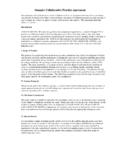Transcription of Module 1
1 Module 1 Scope 1 Emissions Accountingin partnership with and Module 1 Scope 1 Emissions Accounting2 For informational purposes only. Not legal advice or to Module 1: Scope 1 Emissions AccountingBefore we start our training, please find the keys to our interactive PDF. Previous pageExpand windowKey conceptsFurther resourcesHomeMinimize windowSteps needed to prepare for accounting emissionsNext pageClick here for more informationCheck out this videoModule 1 Scope 1 Emissions Accounting3 For informational purposes only. Not legal advice or to Module 1: Scope 1 Emissions AccountingWe estimate this Module will take 25 minutes for a first read-through. It can then be used as a step-by-step guide as you complete your Scope 1 emissions Module will take you through the step-by-step process for accounting for your company s Scope 1 GHG emissions. As a reminder, Scope 1 emissions are caused by sources owned or controlled by the company for example, emissions from combustion in owned or controlled boilers, furnaces, vehicles, etc.
2 Or emissions from chemical production in owned or controlled process equipment. These emissions will be largest for companies in sectors like manufacturing, energy and freight that create a lot of their own emissions on site. They are likely to be lower for companies in sectors like professional services, financial services and information technology. However, companies in these sectors may still have Scope 1 emissions from sources like company-owned or leased 1 Scope 1 Emissions Accounting4 For informational purposes only. Not legal advice or objectivesIn this Module , you will learn: The benefits and challenges of using free GHG emissions accounting tools to help you with accounting Scope 1 emissions The five overarching steps to calculate Scope 1 emissions The complicating factors to be aware of when calculating Scope 1 emissions How to use the GHG Emissions Calculation Tool to do your Scope 1 emissions accounting1.
3 Assess Greenhouse Gas Emissions3. Shift to Low- or No-Emission Energy2. Optimize Energy UseGreenhouse Gas Emissions AccountingCapacity Building ObjectiveRenewable Energy ProcurementEnergy EfficiencyThis training is the first part of a capacity building series on reducing energy-related greenhouse gas emissionsModule 1 Scope 1 Emissions Accounting5 For informational purposes only. Not legal advice or you complete this Module , the following modules remain: Module 2 Scope 2 Emissions AccountingModule 3 Scope 3 Emissions AccountingModule 4 Emissions Reductions 101 Module 1 Scope 1 Emissions Accounting6 For informational purposes only. Not legal advice or to know before you get startedModule 1 Scope 1 Emissions Accounting7 For informational purposes only. Not legal advice or we dive inModule 1 Scope 1 Emissions Accounting8 For informational purposes only. Not legal advice or we dive in, let s first talk about how tools can help you with emissions accountingThere are a variety of different free tools available to help with emissions accounting.
4 They have a set of benefits and challenges that are outlined below: Module 1 Scope 1 Emissions Accounting9 For companies at the beginning of their emissions accounting journey, we suggest using the GHG Emissions Calculation Tool for Scope 1 accounting for the following reasons: It was developed by the World Resources Institute (WRI) and strictly follows the GHG Protocol guidance It has been recently updated (as of March 2021) and is likely to be updated periodically It allows users to easily include their own emissions factors (we will explain this in more detail later in this Module )This tool can be accessed tools and databases are listed on the GHG Protocol website if you d like to learn more about options beyond the GHG Emissions Calculation informational purposes only. Not legal advice of counsel. Please check the GHG Protocol website at for the latest tools, including updates and 1 Scope 1 Emissions Accounting10 How does the GHG Emissions Calculation Tool work?
5 The GHG Emissions Calculation Tool is an Excel-workbook with different tabs for accounting various emissions from your company s activities. These are the tabs that you ll want to focus on for Scope 1 emissions accounting. We will talk about the other tabs in later modules. Key tabs for Scope 1 accountingFor informational purposes only. Not legal advice of counsel. Please check the GHG Protocol website at for the latest tools, including updates and 1 Scope 1 Emissions Accounting11 For informational purposes only. Not legal advice or is the step-by-step process for calculating Scope 1 emissions?Below is the step-by-step approach to calculating Scope 1 emissions. On the most basic level, these steps involve two main types of activities: gathering data and doing multiplication. Using the GHG Emissions Calculation Tool will help you do most of these steps in one place. The rest of this Module will take you through these five steps.
6 Steps involving gathering dataSteps involving doing multiplicationDevelop a comprehensive list of all Scope 1 emissions sources associated with four types of sources: Stationary combustion Mobile combustion Fugitive sources Physical/chemical processesCompile annual activity, usage, and consumption data from your company Identify appropriate emissions factors for each type of GHG (We will explain this in more detail later in this Module .)Estimate CO2, CH4, and N2O emissions (and any other applicable GHGs) by multiplying the results of steps B, and CConvert to carbon dioxide equivalents (CO2e). (Think of this as translating other types of GHG emissions into their CO2 equivalent so that all emissions can be added together.)Note: Some emissions factors convert to CO2e for you, in which case you can skip this step. ABCDEThe GHG Emissions Calculation Tool will help you with these 3 stepsModule 1 Scope 1 Emissions Accounting12 For informational purposes only.
7 Not legal advice or the below checklist of emissions sources and create a list of those that apply to your companyBelow we define each type of Scope 1 emissions and provide a checklist of where these emissions come from. Read through these definitions and then create a list of all of the different sources that apply to your company. Many of these emissions apply to sectors associated with manufacturing, energy and freight that create a lot of their own emissions on site. Step AEmission typeDefinitionSource checklistStationary combustionEmissions from stationary combustion of fuels in company-owned or controlled stationary sources 9 Combustion of fuels in boilers 9 Combustion of fuels in furnaces 9 Combustion of fuels in burners 9 Combustion of fuels in turbines 9On-site energy productionMobile combustionEmissions from mobile combustion of fuels in company-owned or controlled mobile sourcesCombustion of fuel in vehicles owned or leased by your company used for transport of.
8 9 Materials 9 Products 9 Waste 9 EmployeesFugitive sourcesEmissions from intentional or unintentional releases from the production, processing, transmission, storage and use of fuels and other substances that do no pass through a stack, chimney, vent or exhaust pipe 9 Releases of SF6 from electrical equipment 9 HFC releases during the use of refrigeration and air conditioning equipment 9CH4 leakage form natural gas transportPhysical/chemical processesEmissions from any physical or chemical processes other than fuel combustionRelease of CO2 or other GHGs associated with the manufacture of: 9 Cement 9 Aluminum 9 SteelModule 1 Scope 1 Emissions Accounting13 For informational purposes only. Not legal advice or annual activity, usage and consumption data: Where can I find data in my company?Step BEmission typeWhere to find at your companyStationary combustion 9 Utility bills for natural gas, propane and fuel oil 9 Invoices for fuel purchases 9 Data on duration of operation of equipment Note.
9 This will need to be multiplied by the fuel consumption rate to estimate total fuel consumptionMobile combustion 9 Invoices for fuel purchases for your fleet 9 Data on vehicle mileage (can use odometer readings) multiplied by reported fuel economy rate to estimate total fuel consumptionFugitive sources 9 HVAC or refrigeration maintenance records showing quantity of refrigerants used and purchasedPhysical/chemical processes* (relevant to only certain industry sectors ( , oil & gas, cement, aluminum, etc)) 9 Process manager/engineer 9 Manufacturing manager/engineer* Note, for the purposes of this Module , it is assumed that process emissions will likely not be applicable. If Process Emissions are relevant to your organization s operations, consult sector-specific tools via GHG Protocol ( ) Module 1 Scope 1 Emissions Accounting14 For informational purposes only. Not legal advice or appropriate emissions factors: Where do I find emissions factors?
10 Step CModule 1 Scope 1 Emissions Accounting15 For informational purposes only. Not legal advice or appropriate emissions factors: Where can I find the most up to date emissions factors?There is no one-stop-shop for emissions factors. Various organizations and agencies compile data to develop factors in different ways that result in different factors. Furthermore, emissions factors are revised/refined as the science evolves and methods are improved. Below are three places to look for the most up-to-date emissions factors for Scope 1 emissions accounting:Step CUnited States Environmental Protection Agency (US EPA) GHG Emission Factors Hub Access here (Click on the PDF or Excel Workbook titled: GHG Emissions Factors Hub)Benefits: Relatively user-friendly, free of chargeChallenges: US-onlyThe Climate Registry Default Emission Factors Access hereBenefits: Includes factors for US and CanadaChallenges: Relatively less user-friendly, (many emissions factors spread out across numerous tables)UK Department for Environment Food & Rural Affairs (DEFRA)Access hereBenefits: UK emissions factors that can also be used as a proxy for other you can t find the emissions factors you need from the other two sources, then check hereModule 1 Scope 1 Emissions Accounting16 For informational purposes only.








